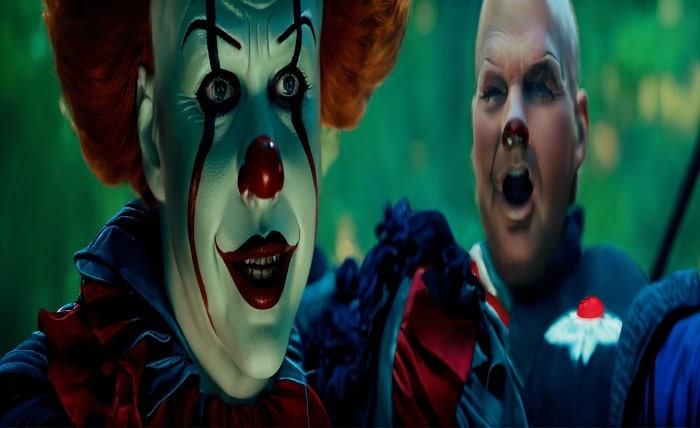The Allure of Horror Movies: A Deep Dive into the Genre’s Enduring Appeal

Introduction
Horror movies have long captivated audiences with their unique ability to evoke fear, suspense, and excitement. From the silent film era to the latest releases, horror movies have evolved significantly, yet their core purpose remains the same: to thrill and terrify. This genre taps into primal fears, offering a safe space to explore the darker sides of human nature.
The allure of horror movies lies in their ability to evoke intense emotions. Unlike other genres, horror movies engage the audience in a visceral way, often leaving a lasting impact. The fear elicited by horror movies can be both exhilarating and cathartic, providing an escape from the mundane and a way to confront and conquer personal fears.
The Evolution of Horror Movies
The history of horror movies dates back to the late 19th century, with early examples like Georges Méliès’ “Le Manoir du Diable” (1896). These early horror movies were short, silent films that relied heavily on atmosphere and visual effects to convey fear. As technology advanced, so did the sophistication of horror movies.
In the 1930s, Universal Studios popularized horror movies with iconic monster films such as “Dracula” (1931) and “Frankenstein” (1931). These horror movies introduced audiences to unforgettable characters and set the stage for future supernatural tales. The 1950s saw a shift towards science fiction horror movies, reflecting societal fears of nuclear war and alien invasions.
The 1960s and 1970s brought a new wave of horror movies, characterized by psychological horror and graphic violence. Alfred Hitchcock’s “Psycho” (1960) and George A. Romero’s “Night of the Living Dead” (1968) redefined the genre, focusing on human monsters and societal breakdowns. The 1980s and 1990s saw the rise of slasher horror movies like “Halloween” (1978) and “Scream” (1996), which became cultural phenomena.
Iconic Horror Movies and Their Impact
Several horror movies have left an indelible mark on both the genre and popular culture. One of the most influential horror movies is “The Exorcist” (1973), which terrified audiences with its portrayal of demonic possession. This film set a new standard for supernatural horror movies, blending psychological terror with shocking special effects.
Another landmark in horror movies is “Jaws” (1975), directed by Steven Spielberg. This film not only scared viewers out of the water but also demonstrated the commercial potential of horror movies. Its success paved the way for blockbuster horror movies, proving that fear could be a lucrative business.
“Halloween” (1978), directed by John Carpenter, introduced the world to Michael Myers and became the blueprint for slasher horror movies. Its success spawned numerous sequels and imitators, cementing the slasher subgenre’s place in horror movies. “The Shining” (1980), directed by Stanley Kubrick, remains a masterpiece of psychological horror, exploring themes of madness and isolation.
Psychological Impact of Horror Movies
Horror movies have a profound psychological impact on viewers. The fear experienced while watching horror movies triggers the body’s fight-or-flight response, releasing adrenaline and other stress hormones. This physical reaction can be both thrilling and addictive, explaining why many people are drawn to horror movies despite the discomfort they cause.
One reason horror movies are so compelling is their ability to tap into universal fears. Common themes in horror movies, such as death, the unknown, and loss of control, resonate deeply with audiences. By confronting these fears in a controlled environment, viewers can achieve a sense of mastery and resilience.
Moreover, horror movies often explore societal anxieties and cultural taboos. For example, zombie horror movies like “Dawn of the Dead” (1978) reflect fears of consumerism and social decay, while body horror movies like “The Fly” (1986) delve into concerns about science and technology. By addressing these issues, horror movies provide a lens through which to examine and understand collective fears.
Subgenres of Horror Movies
Horror movies encompass a wide range of subgenres, each offering unique ways to scare and entertain. One of the most popular subgenres is supernatural horror, which includes films about ghosts, demons, and otherworldly entities. Examples of supernatural horror movies include “The Conjuring” (2013) and “The Ring” (2002).
Slasher horror movies, characterized by a killer stalking and murdering victims, are another enduring subgenre. “A Nightmare on Elm Street” (1984) and “Friday the 13th” (1980) are classic examples of slasher horror movies that have spawned numerous sequels and inspired countless imitators.
Psychological horror movies focus on the mental and emotional states of characters, often blurring the line between reality and madness. “Black Swan” (2010) and “Get Out” (2017) are modern examples of psychological horror movies that explore themes of identity, paranoia, and societal pressures.
Body horror movies, such as “The Thing” (1982) and “Videodrome” (1983), focus on physical transformation and mutilation. These horror movies often explore fears related to the fragility of the human body and the loss of personal autonomy.
The Role of Special Effects in Horror Movies
Special effects play a crucial role in the success of horror movies. From practical effects like makeup and prosthetics to digital effects like CGI, these techniques bring the terrifying visions of horror movies to life. Early horror movies relied heavily on practical effects, with pioneers like Lon Chaney Sr. using innovative makeup techniques to create iconic monsters.
The advent of CGI in the 1990s revolutionized horror movies, allowing for more realistic and elaborate scares. Films like “Jurassic Park” (1993) and “The Mummy” (1999) showcased the potential of digital effects to enhance horror movies, blending practical and digital techniques for maximum impact.
Despite the advances in technology, practical effects remain a staple of horror movies. Many filmmakers, like Guillermo del Toro in “Pan’s Labyrinth” (2006), continue to use practical effects to create tangible, realistic horrors. The combination of practical and digital effects ensures that horror movies can continue to innovate and terrify audiences.
The Cultural Significance of Horror Movies
Horror movies hold significant cultural value, reflecting societal fears and values throughout history. In the early 20th century, horror movies often depicted monsters and supernatural beings as metaphors for the unknown and the other. These films explored themes of xenophobia and the fear of the unfamiliar.
During the Cold War era, horror movies shifted to reflect anxieties about nuclear war and scientific experimentation. Films like “Godzilla” (1954) and “Invasion of the Body Snatchers” (1956) used horror to comment on the potential dangers of technological advancements and the loss of individuality.
In contemporary times, horror movies continue to address relevant social issues. Jordan Peele’s “Us” (2019) and “Candyman” (2021) tackle themes of race, class, and identity, using horror as a lens to examine systemic inequalities. These films demonstrate the genre’s ability to engage with complex cultural dialogues while delivering scares.
The Global Appeal of Horror Movies
Horror movies are a global phenomenon, with different cultures contributing unique perspectives and stories to the genre. Japanese horror movies, or J-horror, gained international popularity with films like “Ringu” (1998) and “Ju-on: The Grudge” (2002). These movies are known for their atmospheric tension and psychological scares, influencing Western horror movies.
Similarly, South Korean horror movies have made a significant impact, with films like “Train to Busan” (2016) and “The Wailing” (2016) garnering critical acclaim. These horror movies often blend traditional folklore with modern fears, creating a unique and compelling horror experience.
European horror movies, particularly those from Italy and Spain, have also left a mark on the genre. Italian director Dario Argento’s “Suspiria” (1977) is a classic example of visually stunning horror, while Spanish films like “The Orphanage” (2007) combine emotional depth with supernatural elements.
The Future of Horror Movies
The future of horror movies looks promising, with advancements in technology and storytelling continuing to push the boundaries of the genre. Virtual reality (VR) and augmented reality (AR) offer new ways to immerse audiences in horror experiences, making them active participants in the scares.
Additionally, the rise of streaming platforms has democratized the production and distribution of horror movies. Independent filmmakers now have greater opportunities to showcase their work, leading to a diverse array of horror movies that explore unconventional themes and styles.
Moreover, the increased representation of diverse voices in horror movies is reshaping the genre. Filmmakers from different backgrounds bring fresh perspectives and stories, ensuring that horror movies remain relevant and resonant with a broad audience.
Conclusion
Horror movies continue to captivate audiences with their ability to evoke fear and excitement. From their early beginnings to the present day, horror movies have evolved, reflecting societal fears and technological advancements. The genre’s enduring appeal lies in its capacity to explore the darker sides of human nature and confront universal fears.
As horror movies continue to innovate and diversify, they will undoubtedly remain a vital part of the cinematic landscape. Whether through traditional supernatural tales or cutting-edge VR experiences, horror movies will continue to thrill and terrify audiences for generations to come.
FAQs
1. Why do people enjoy watching horror movies?
People enjoy watching horror movies because they evoke intense emotions like fear and excitement. This adrenaline rush can be thrilling and provides a safe way to confront personal fears.
2. What are some iconic horror movies that everyone should watch?
Iconic horror movies include “The Exorcist,” “Jaws,” “Halloween,” “The Shining,” and “Psycho.” These films have significantly influenced the genre and are essential viewing for horror fans.
3. How have horror movies evolved over the years?
Horror movies have evolved from silent films with basic special effects to sophisticated productions using advanced CGI. They have also shifted in themes, reflecting societal fears and cultural changes over time.
4. What are the different subgenres of horror movies?
Subgenres of horror movies include supernatural horror, slasher horror, psychological horror, body horror, and science fiction horror. Each subgenre offers unique ways to scare and engage audiences.
5. What role do special effects play in horror movies?
Special effects are crucial in horror movies, bringing terrifying visions to life. Both practical and digital effects are used to create realistic and impactful scares, enhancing the overall experience for viewers.





